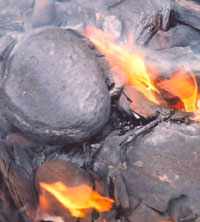
Photo from wikipedia
A natural analogue study in CO2-rich coalfield (Haishiwan, China) provides a strong support for safe, reliable, and long-term storage by analyzing the mechanism of CO2 migration, entrapment, and storage in… Click to show full abstract
A natural analogue study in CO2-rich coalfield (Haishiwan, China) provides a strong support for safe, reliable, and long-term storage by analyzing the mechanism of CO2 migration, entrapment, and storage in coal reservoir. Thus, effects of geological tectonism on reservoir properties were investigated. Simultaneously, coal and oil shale samples before and after supercritical CO2 (SCCO2) treatment via geochemical reactor were collected to analyze changes in pore structure, functional group distributions, and SCCO2 extraction. Observations from in situ properties of coal seam indicate that there is a positive relationship with CH4 contents and F19 fault whereas CO2 and carbonate contents decrease as the distance from F19 increases. Analysis of pore properties reveals that SCCO2 enlarges the development of coal pore and facilitates the diffusion and seepage channel of coal reservoir, while no changes in larger pores are found in oil shale, which may restrain fluids from passing through. Then, oxygen-containing functional groups are mobilized by SCCO2 from oil shale, associated with a decrease in sorption sites. The sealing capacity of cap rock (oil shale) and geological tectonism (F19 fault), as the major contributors to CO2 enrichment and accumulation, provides insights into the suitable selection of CCGS site for long geological time.
Journal Title: Geofluids
Year Published: 2018
Link to full text (if available)
Share on Social Media: Sign Up to like & get
recommendations!